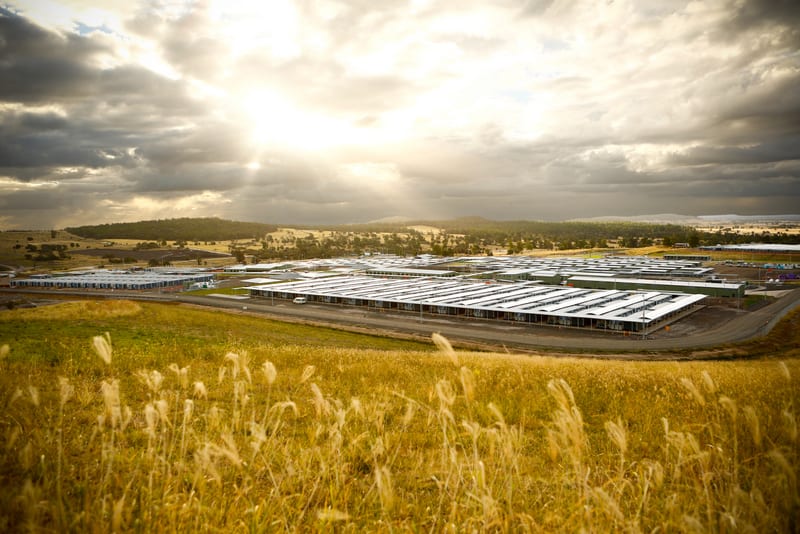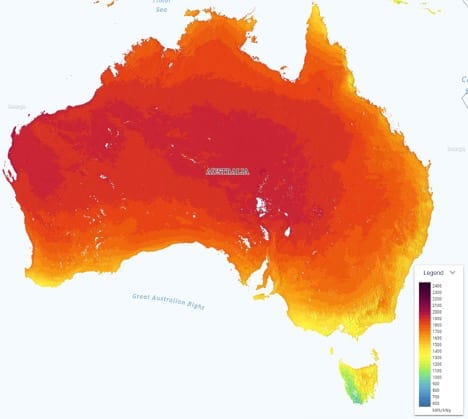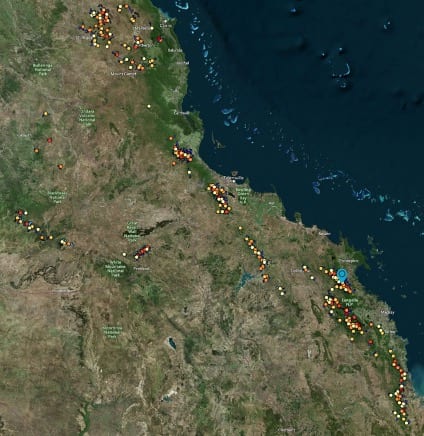Australia has some of the best wind and solar resources in the world, but many of them are not connected to the country’s main grid.
Connecting those regions allows smoothing of the overall supply of wind and solar and greatly reduces the amount of storage needed to supply reliable solar and wind electricity to south eastern cities.
Newly published modelling from the Australian National University shows that the savings from reduced storage costs is larger than the cost of long-distance transmission from remote Australia to energy-hungry south eastern cities.
We’ve modelled a truly national electricity grid by extending the existing National Electricity Market to Far North Queensland (1500 km), Alice Springs (1200 km) and Perth (2400 km).
Far North Queensland (FNQ), Western Australia and Alice Springs have excellent wind (Figure 1) and solar (Figure 2) energy resources. And there are also vast opportunities for off-river pumped hydro energy storage (Figure 3).
The results show that an investment of roughly $100 billion – $55b in north Queensland, $40b around Perth in Western Australia and $5b in Alice Springs – would help create a reliable, zero-emissions and lowest cost national electricity market.
Zero-carbon energy enables removal of 80% of the greenhouse gas emissions from the Australian economy. In an expanded electricity system in which all energy required for land transport, buildings, manufacturing and mining comes from solar and wind electricity then the amount of electricity required is doubled and total Australian emissions decline by 80%. The all-in cost of electricity is estimated to be $70-82 per megawatt-hour.
How to connect? A very promising option is to use High Voltage Direct Current (HVDC) transmission to create a truly national renewable electricity grid (Figure 4) that also reduces electricity prices.

Modern HVDC transmission technology enables cost-effective delivery of multi-Gigawatt-scale electric power over thousands of kilometres with low transmission loss (3% per 1000 km).
An HVDC connection from Townsville to Sydney (1800 km) with a capacity of 5 Gigawatts (GW) would cost approximately $5 billion and would be capable of transporting the output of 7-10 GW of new solar and wind farms worth $10-15 billion.
Three or four such transmission lines with attached solar and wind farms are optimum in a 100% renewable energy system.
The resulting investment in FNQ (solar, wind, transmission and storage) is about $55 billion.
Connecting Western Australia to the eastern states via HVDC accesses excellent solar and wind resources and also different weather. It also accesses different time zones – the sun keeps shining in Perth for two hours after the sun sets in Sydney.
Connecting the west and the east via South Australia helps everyone. Alice Springs has excellent sun and wind, and additionally has extensive off-river pumped hydro energy storage opportunities.
Together, the investments on solar, wind, transmission and storage would be $100 billion in north Queensland ($55 billion), Western Australia ($40 billion) and Alice Springs ($5 billion) to support 100% renewable energy in Australia.
Solar photovoltaics (PV) and wind energy constitute about two thirds of global net generation capacity additions, and nearly 100% of new capacity in Australia – because they are cheaper than alternatives.
Australia is deploying 22 Gigawatts (GW) of new wind and solar over 2018-21, which is 4-5 times faster per capita than China, the USA, Japan or the EU. This is causing Australia’s emissions to decline.
If Australia continues to deploy new wind and solar at the current rate (6-7 GW per year) then it will meet its Paris target in 2030.
If the rate increases to 15 GW or 22 GW per year then all oil, gas and coal will be driven out of the economy by 2050 or 2040 respectively, leading to an 85% reduction in greenhouse emissions.
However, lack of new transmission to bring the solar and wind power to the cities threatens to throttle Australia’s renewable energy pipeline.
Obsolete Government processes for approving construction of new transmission have woefully failed to keep up with the speed of deployment of wind and solar. Australia’s emissions may start to increase again because solar and windfarm investment is slowing.
A good solution is to nominate Renewable Energy Zones – places with excellent wind, solar and pumped hydro resources. Strong transmission can be built to allow the renewable energy to reach the cities.
Roughly speaking, construction of enough wind, solar, transmission and storage to drive all oil, gas and coal out of the economy by 2050 entails the capital expenditure of about $12 billion per year (all of which will be recovered through normal energy tariffs).
Much of this money will go into the dozen or so best Renewable Energy Zones scattered along the Great Dividing Range.
A balanced 100% renewable electricity system comprises wind and solar collectors, existing hydro and biomass, and enough storage and transmission to ensure that demand can be met at all times.
ANU modelling shows that the cost of electricity from a balanced 100% renewable electricity system is about $75 per Megawatt-hour, which is below the average wholesale market price for 2019. Emissions would decline by one third.
However, emission reductions don’t need to stop at driving coal and fossil gas out of the electricity system.
Oil can be driven out of land transport (electric vehicles), fossil gas can be driven out of heating (heat pumps, electric furnaces), and fossil fuels can be driven out of industry (metals, chemicals and the like).
In an expanded electricity system in which all energy required for land transport, buildings, manufacturing and mining comes from solar and wind electricity then the amount of electricity required is doubled and total Australian emissions decline by 80%.
Fugitive emissions of methane will vanish as fossil fuels are phased out from the energy industry.
Our modelling shows that the all-in cost of electricity would be $70-82 per Megawatt-hour. This assumes strong HVDC connection to north Queensland’s wonderful solar and wind resources.
Without this connection the cost of electricity increases by 10% due to the need for more storage and generation in the south, costing consumers $2-4 billion extra per year.
Our modelling also covered HVDC connection of Alice Springs or Perth to the southeast. Connection to Perth is of major benefit to the people of southwest Western Australia.
However, in neither case is there a significant benefit to the east coast market. This emphasises the importance of north Queensland.
Solar and wind energy are the future of energy and coal represents the past. It is puzzling that some members of Parliament representing rural electorates are anti-renewables.
The solar farms, wind farms, transmission and pumped hydro storage is all going into rural areas, resulting in large-scale job opportunities.













